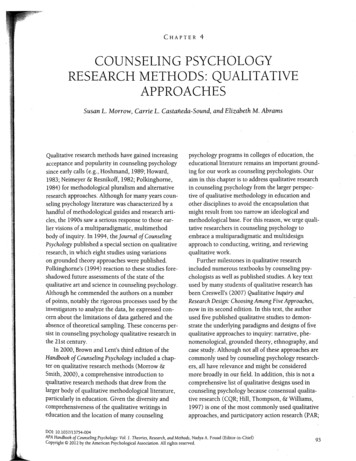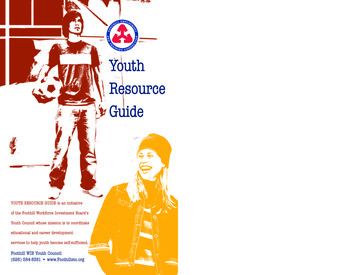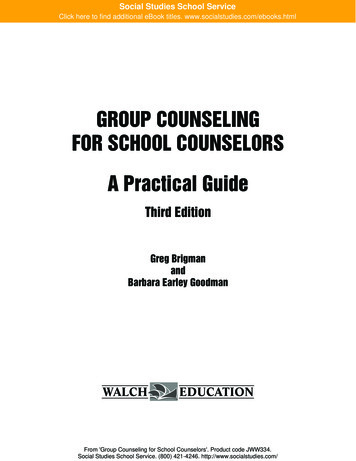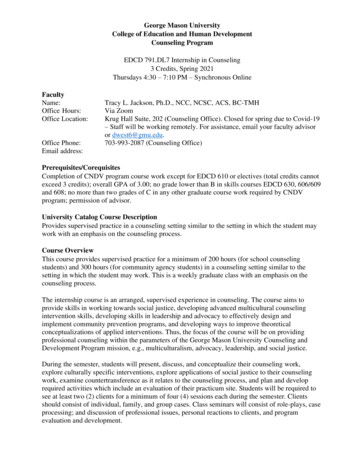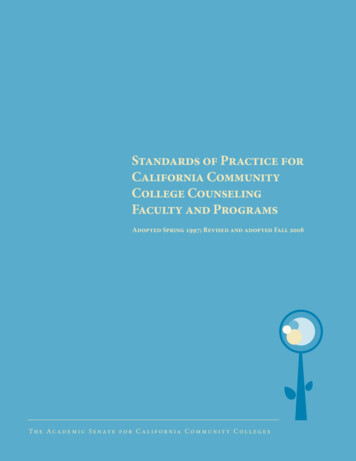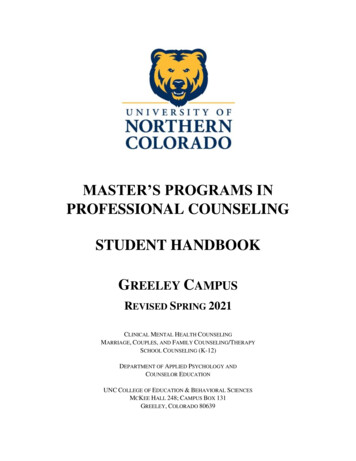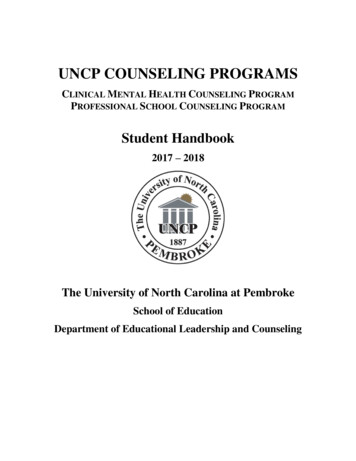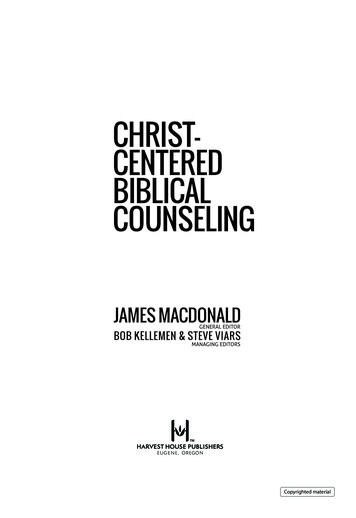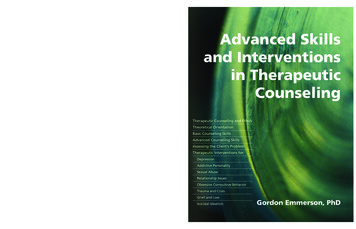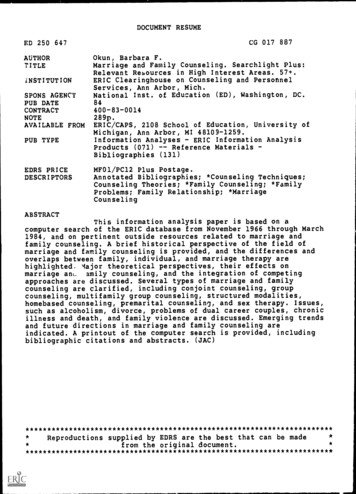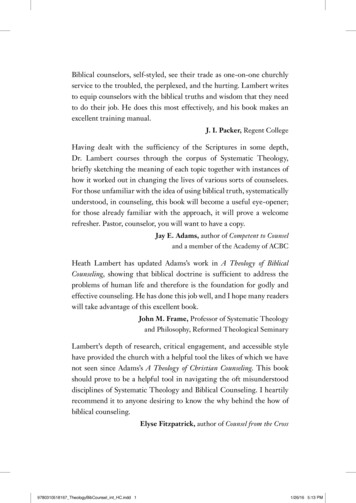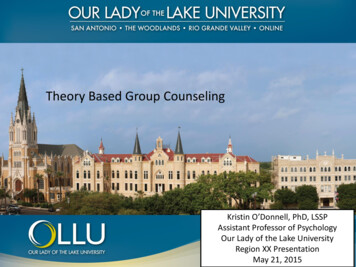
Transcription
Theory Based Group CounselingKristin O’Donnell, PhD, LSSPAssistant Professor of PsychologyOur Lady of the Lake UniversityRegion XX PresentationMay 21, 2015
Agenda Importance of Theoretical Foundations Steps for Group Development Narrative Therapy– Sample Group
Benefits of Group Counseling Young people and group effectiveness– Groups are the treatment of choice foradolescents, why?– Are groups successful with young children?
An Equation for Change Client Factors Relationship Factors Hope of Expectancy Model of Theoretical Orientation The Group
Client Factors StrengthsTalentsResourcesGiftsSocial SupportsValues
Relationship Factors Alliance & perceived support between thepractitioner and participant Includes:– Level of respect– Acceptance– Warmth Complex as leader has a relationship witheach member
Hope of Expectancy Group leaders are in a unique position toignite hope (sometimes the students have yetto see strengths in themselves) By identifying the best in students they beginto see it for themselves
Model of Theoretical Orientation Model directly impacts relationship factorsand hope of expectancy Model should enhance other factors and fitwell in the school setting Model should match student expectations andleader’s personal style
The Group Interactions & feedback can be powerful tomembers Using research can make groups a safe,organized and productive endeavor
The Importance of a TheoreticalModel Strong potential for affecting the other areasof the equation for change Factor over which we have the most control Provides a foundation for the group so thatactivities are not fragmented Provides for integrated experiences Places us in a great position to effect change
How a Theoretical OrientationDirectly Affects Students Becomes a framework around which weunderstand students and their group Helps us to have a guide as groups are createdwhich in turn helps students to have structure
Which Model? The model we choose depends upon– The goals and theme of the group– Developmental needs of the members– The setting– Leader’s training & experience
No “Perfect” Theoretical Model Ask yourself which model is best for thisspecific situation No single approach has proven to be moreeffective than others.
Getting a Group Started Get Administrative ApprovalMeet With TeachersGet Parental PermissionChoose Developmentally AppropriateActivities
Facilitating a Group Select a scope and sequence of topicsdependent upon:– Group members– Relationships– Politics of the school Select a theoretical model based on:– Comfort level and knowledge of the theoreticalmodel– Best fit for the factors mentioned above
Sample Session Outline Suggested Session Outline for a CulturalIdentity Group:1)2)3)4)5)6)7)Getting to know each other/Setting goalsWho am I?Family identityHeroes and SheroesMusicFairness in our schoolDiscrimination in our town
Sample Session Outline Suggested session outline for a social skillsgroup focusing on communication:1)2)3)4)5)6)7)Getting to know each other/Setting goalsLearning to ListenEye contactDon’t interruptActive listeningWaitingGroup closure session
Facilitating a Group 1st Session:– Discussion of what this group is all about (shouldbe tailored to developmental level of the group)– Get to know each other activities (Icebreakers)– Build Group Cohesion Choose a name for the group Have group create rules for participation
Narrative TherapyThe epitome of creating the life storyAccomplished by the choices or perceived lack ofchoices for peopleTherapist attempts to create a new story of personalempowermentNew stories lead to increased satisfaction of clientand new hopefulness
Assumptions about Problems inNarrative Therapy Person is situated in their or others stories andthey see no alternative Person is an active participant in thisunsatisfying story Story is insufficient in representing person’sexperiences
Types of Stories Oppressive Stories Alternative Stories Gaps
Focus of Narrative Therapy Create alternate stories Alternate stories contain a more positiveperspective Narratives are representations of identities
Narrative Maps This is the term that refers to how peopleorganize important aspects of their life to“weave the tapestry of their life’s story”(social constructs)– Social constructs: interactions and experienceswith others in a historical context
Deconstruction Deconstructive listening Deconstructive questioning
Practices in Narrative Therapy Position Collaboratively Externalize the Problem Excavate Unique Outcomes– Opening space– Exception questions– Hypothetical questions
Sample Group 6 week, Keep Calm counseling group focusingon emotions:1) Keep Calm & Bond: Getting to know eachother/Setting goals2) Keep Calm & Find Happiness3) Keep Calm & Find Peace4) Keep Calm & Find Hope5) Keep Calm & Find Honesty6) Group Closure
Session 2: Keep Calm and FindHappiness Introduce the topic for the day (happiness vs. sadness)Have the group define each feelingRead the book “Little Miss Happy”Once the book is read have members identify the mainthemes of the character’s stories and discuss the feedbackloop that each character is stuck in. Also discuss the sign thatstates the rules of Miseryland and how these rules help toconstruct the townspeople’s stories.– Have members develop a sign that guards their own cityand keeps happiness away (things in their lives that makeit difficulty to be happy).
2nd Session Continued Ask those who are willing to share their sign. Discuss how Little Miss Happy changed therules and helped the city to rewrite theirstories. Have members turn their papers over andrewrite their signs to let happiness in. To close the group discuss how we can live byrules that cause us to not be happy but with alittle bit of re-writing things can changedramatically.
References Cooley, L. (2009). The power of groups:Solution-focused group counseling in schools.Corwin. Thousand Oaks, CA. Corey, G. (2013). Theory and practice ofcounseling and psychotherapy (9th Ed).Belmont, CA: Brooks/Cole. Khalsa, S.S. (1996). Group exercises forenhancing social skills and self-esteem.Professional Resource Exchange. Sarasota, FL
References (continued) Parsons, R.D. (2007). Counseling strategies thatwork! Evidenced-based interventions for schoolcounselors. Pearson Education, Inc. Boston, MA. Plotts, C.A. & Lasser, J. (2013). School psychologistas counselor: A practitioner’s handbook. NationalAssociation of School Psychologists. Bethesda, MD. Winslade J.M. & Monk, G.D. (1999). Narrativecounseling in the schools: Powerful and brief, 2ndEdition. Corwin Press. Thousand Oaks, CA.
Contact Information Kristin O’Donnell, PhD, LSSPklodonnell@lake.ollusa.edu(210) 528 - 6728
Solution-focused group counseling in schools. Corwin. Thousand Oaks, CA. Corey, G. (2013). Theory and practice of counseling and psychotherapy (9th Ed). Belmont, CA: Brooks/Cole. Khalsa, S.S. (1996). Group exercises for enhancing social skills and
